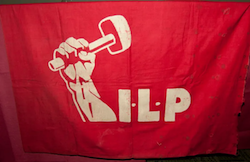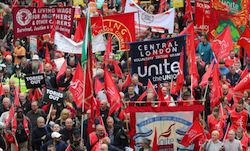VINCE MILLS marks the 90th anniversary of the Independent Labour Party’s disaffiliation from the Labour Party in July 1932 by examining the significance of the trade union link. He calls for the current Labour left to stick with the party and not add to the long list of failed attempts to build a socialist alternative.
“Too many socialist parties. Not enough socialists” – Tony Benn
Since Sir Keir Starmer blagged his way into the leadership of the Labour Party, there has been a lot of soul-searching about whether socialists should remain in the Labour Party or even help build a left-wing alternative – less, I notice, consideration of joining existing left alternatives – more of them later.
 The British left inside and outside the Labour Party has faced this dilemma time and again, but perhaps the consequences of adopting such a strategy have never been more dire than the ILP’s disaffiliation from Labour in 1932, exactly 90 years ago.
The British left inside and outside the Labour Party has faced this dilemma time and again, but perhaps the consequences of adopting such a strategy have never been more dire than the ILP’s disaffiliation from Labour in 1932, exactly 90 years ago.
Ramsay MacDonald, the Labour Party leader, had betrayed the party by forming a coalition with the Tories and Liberals – the so-called “national government”. That coalition then routed the Labour Party in the subsequent general election of 1931.
Following that defeat, Jimmy Maxton (left), the radical socialist ILP MP for Glasgow Shettleston, offered this analysis of Labour’s performance: “To me their failure was due to a complete lack of faith in Socialism … I firmly believe that out of the defeat … there will develop speedily a new political Socialist movement of the working class…”
Maxton had reason to believe it. It was after all a period of resistance to mass unemployment and the means test, dramatically expressed in the hunger marches. But he was entirely wrong about the prospects of a socialist party building support outside the ranks of the Labour Party.
Following the decision to disaffiliate, between July and November of 1932, the ILP lost 203 out of its 653 branches, losing 128 in Scotland alone.
Forty, out of the 44 ILP councillors in Glasgow left the ILP. By 1935 the ILP, despite playing an important role in the Unity Campaign, hunger marches, and anti-fascist activities, had fewer than 5,000 members.
It had had 28,000 members before disaffiliation, although only 16,700 of those left the Labour Party in 1932.
According to Labour historian Ian Donnachie, after disaffiliation more and more ILPers returned to the Labour Party, and it was Labour in government in 1945 that delivered the kind of programme the ILP’s 1926 Socialism In Our Time had envisaged.
Socialist failures
The ILP was only the first in a long line of similar failures. The following list is not meant to be inclusive; it is only those that I am aware of, and that is heavily influenced by living in Scotland: the Commonwealth Party in the 1940s, Jim Sillars’s Scottish Labour Party in the 1970s, the Scottish Socialist Party and the Socialist Labour Party and the Socialist Party in the 1990s, Respect in 2004, and more recently still the Trade Unionist and Socialist Coalition (TUSC) and Left Unity.
 These examples should surely tell us that there is a profound problem in building a new socialist formation of any sort which does not have a mass base, an integral part of which is the trade union movement.
These examples should surely tell us that there is a profound problem in building a new socialist formation of any sort which does not have a mass base, an integral part of which is the trade union movement.
That is not to say that trade union engagement in the Labour Party of necessity pushes that party to the left. As Lewis Minkin argues, the relationship between the Labour Party and the affiliated trade unions has always been contentious.
From a socialist perspective, the unions’ key limitation is that they largely seek to work within the limits of capitalism and sometimes this has led them to supporting the Labour right.
Minkin describes how the trade union delegates to Labour’s NEC were often indispensably supportive of the Party’s right-wing leadership in the 1970s.
Their key strength is that ultimately, they need to articulate the demands of the workers they represent and more recently, at least since the emergence of Blairism, this has favoured the necessity of opposition to neoliberalism to the benefit of the Labour left.
Trade union participation makes the Labour Party a mass party, a party where the working class, for all the limitations the right may try to put on it, has a real voice that is constitutionally enshrined.
Consequently, if organised Labour remains affiliated to the Labour Party, the party cannot, by its very nature, be irrevocably tied to an unfettered capitalist project because capitalism will always seek to extract its profits at the expense of working people. A union that does not at the very least seek to mitigate this cannot survive, at least, not in the long term.
Hence, ultimately their role in the Labour Party, admittedly unevenly performed, has been to push labour to create a favourable legal, economic and social framework for unions and the working people they represent.
Road to confusion
Of course, it is possible that a new alliance of community-based socialist groups and trade unions could come together and form a new left-wing party. But it is worth bearing in mind that it took 24 years after the formation of the Labour Representation Committee in 1900 for the first Labour government to be elected in 1924.
In the current political context, 24 years would be good progress: there would almost certainly be no unanimity among unions on whether they should leave the Labour Party to start again. In addition, some unions, having disaffiliated, might see no point in repeating their ‘error’ by devoting resources to another political party.
In other words, it is likely to be a recipe for reduced trade union influence in politics and competition between trade union supported parties seeking to advance a progressive agenda. This is surely the road to confusion, division and electoral oblivion.
This is not an academic argument. The Trade Union and Labour Relations (Consolidation) Act 1992 requires unions to hold a ballot of their entire membership every 10 years to approve holding a political fund.
Unite last balloted its members in 2013, so there has to be a ballot by the end of next year and although voting for a political fund does not mean that you have to affiliate to the Labour Party, you can’t undertake any political activity, including affiliation, unless you vote to have a political fund. (GMB and Unison will have to ballot by the end of 2024).
The new leader of Unite has made it clear that she is, at best, unhappy with the Labour Party. In 2013 much was made by those in Unite opposing affiliation to Labour, that although holding a political fund was legitimate, desirable even, spending nearly all of it on Labour Party-related activity was not.
It may be difficult to explain that distinction to Unite’s membership and even if Unite manages that, defending the Labour link (it would take a rule change to end it) might be more difficult still.
Compare how Sam Tarry MP and Sharon Graham responded to his sacking from the front bench after he stood on a CWU picket line.
Tarry said it was “time to fight back” and “reclaim our party”. He is now fronting a Momentum-led fightback called “Labour for Labour”.
Graham said: “And if you don’t do that [defend workers] you are no longer the party for workers – that’s the reality.”
But the Labour Party through its affiliated and individual membership (which still stands at around 400,000 mark) is the largest left of centre political movement in Britain.
Whatever weaknesses the Corbyn period exposed, it also highlighted that the left can move Labour in a socialist direction, but to do that the alliance with the trade unions is crucial and must be defended.
—-
Vince Mills is secretary of Glasgow Kelvin CLP and a member of the Red Paper Collective.
This article first appeared in the Morning Star.


